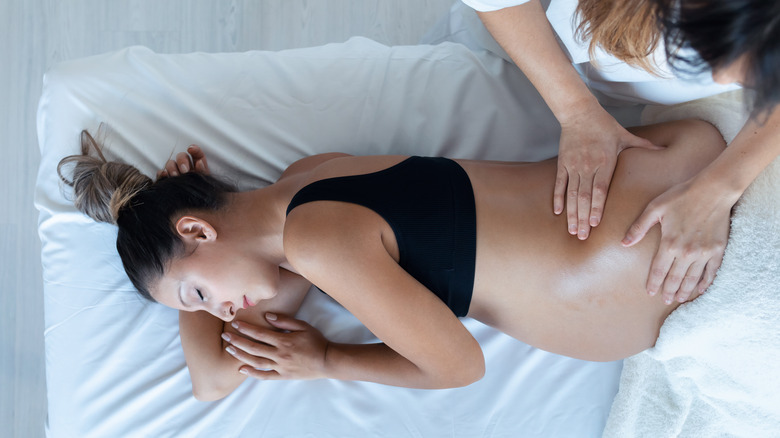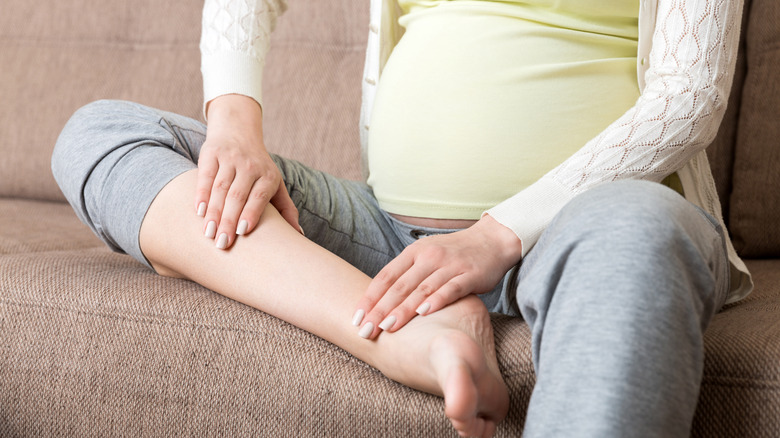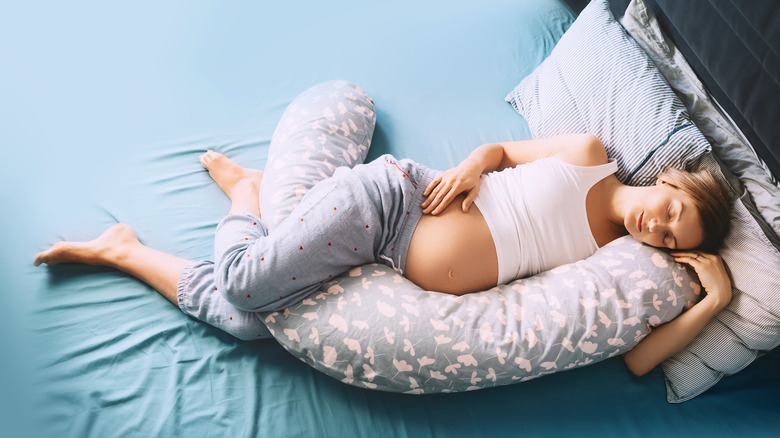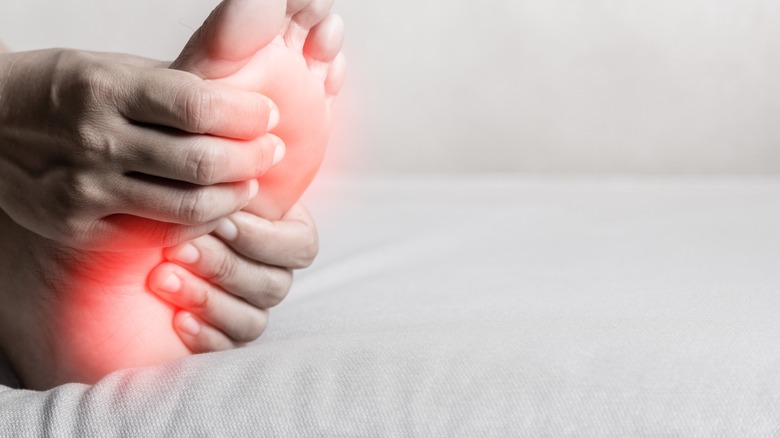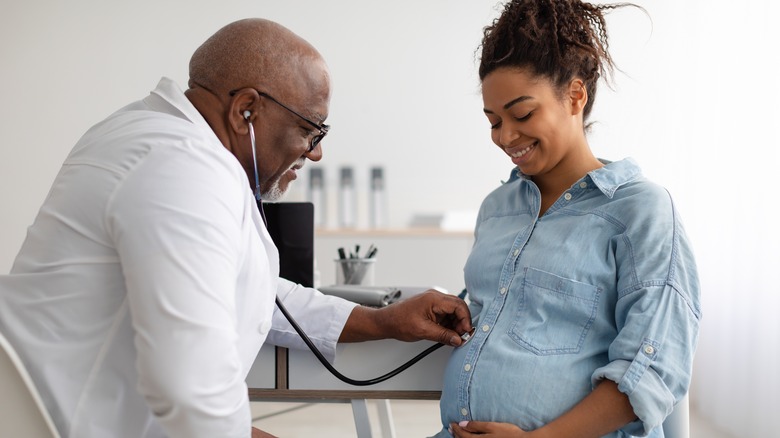What Does A Prenatal Massage Do?
The call for improved healthcare worldwide has led to an increasing number of safe maternal deliveries. According to UNICEF, more women and infants are surviving childbirth — even though we're far from the ideal target. A huge part of this upward trend is due to pregnant women receiving the right care. This is when prenatal massage may be useful. It's a type of massage therapy aiming to facilitate a woman's health, comfort, and relaxation throughout her pregnancy (via Minnesota School of Cosmetology). The massage involves different techniques and objectives, helping to stimulate the muscular and circulatory systems.
This kind of massage therapy is highly specialized and reserved for well-trained professionals due to the numerous risks associated with treating pregnant people. According to WebMD, back pain is common, especially during the second half of pregnancy. Expectant people might also have swelling in the legs and other extremities, which often worsens further into the journey, per the National Health Services (NHS). A prenatal massage might come in handy to curb some of these pregnancy symptoms. However, before engaging in one, it's important to take the necessary precautions and consult your doctor, since prenatal massages are not without risk.
Reduced swelling
According to the American Pregnancy Association, pregnancy-induced swelling of the joints happens when the uterus gets heavier and circulation is affected. Although swelling is a common pregnancy side effect, it might be uncomfortable. A prenatal massage can help reduce discomfort and improve lymphatic functioning, which can help minimize swelling. Reflexology massage might be another great option for those who want to reduce swelling, particularly if hands and feet are in need of relief. (via the Mayo Clinic).
However, not all massages that relieve swelling are safe for pregnant women and their unborn babies. Healthline advises against deep tissue massages — opt for a lighter touch instead. The Mayo Clinic also warns that although swelling in the legs is normal during pregnancy, sudden painful swelling in one leg might also be a sign of deep vein thrombosis — a blood clot, which is a serious health concern. In this case, it's important to consult with your doctor.
Improved sleep
According to a 2020 study published in Comprehensive Psychiatry, insomnia affects about 52% to 61% of pregnant women and usually increases as the pregnancy progresses. While some people don't regard frequently waking up in the middle of the night as a major problem, the study cites various health risks associated with insomnia during pregnancy. Typical risks may include psychiatric disorders, such as depression and anxiety. These disorders may affect both mother and child during the pregnancy and the postpartum period, says the study.
Often, when pregnant women can't sleep at night, it's really not their fault. Sometimes, finding a comfortable sleeping position with a bulging stomach alone can be challenging. This is when a prenatal massage might help. A 2019 study published in the Journal of Nursing and Health Science reported that massages could improve sleep patterns in pregnant women. This might be due to decreased stress hormones and other potential stressors like anxiety and back and leg pain.
Decreased anxiety and depression symptoms
Depression during pregnancy (also known as antepartum depression) is caused by biological changes in the brain (via the American Pregnancy Association). According to the Mayo Clinic, antepartum depression affects about 7% of pregnant women, resulting in symptoms like sadness and loss of interest in day-to-day activities. Sadly, some antepartum depression cases go undiagnosed due to similarities between this condition and pregnancy symptoms, says the clinic.
While various treatment options for depression are available, certain kinds may lead to unwanted side effects. According to a 2017 study published in the journal Interdisciplinary Toxicology, antidepressants, when prescribed to pregnant women, might lead to higher risks of miscarriage and stillbirth.
Massage therapy might be more effective than pharmacological depression treatments in reducing anxiety and depression among pregnant women, as suggested in a 2020 study published in the journal Midwifery. The study, which examines the effects of complementary therapies on maternal anxiety and depression, found that in addition to massage, bright light therapy and acupuncture may reduce the usual symptoms and even save pregnant women from risks carried by some pharmacological interventions. However, further research efforts are needed to draw effective conclusions.
Pain relief
According to WebMD, up to 35% of pregnant women experience wrist pain. This is often due to fluid retention pressurizing the carpal tunnel from the waist to the palm. Other common pregnancy-induced pain symptoms include leg cramps and abdominal pain. A prenatal massage might help improve pregnancy-induced pain and edema symptoms, per a 2014 study published in the journal Expert Review of Obstetrics & Gynecology. According to the study, massages work well for pregnant women because it stimulates pressure receptors which vagal afferent fibers may have innervated due to the pregnancy.
According to a 2010 study published in the journal Expert Review of Obstetrics & Gynecology, engaging in a 20-minute-per-week massage for five weeks may improve common aches and pains and reduce depression. The study also identified a positive relationship between massage therapy and shorter, less painful labor. Another 2020 study published in the Journal of Nursing Research also notes massage therapies may impact dilation and reduce the time spent in labor.
Risks associated with a prenatal massage
According to the American Pregnancy Association, it's important to choose a certified therapist for your prenatal massage since they've received specialized training. An experienced therapist can help monitor symptoms of blood clots and varicose veins, and provide solutions when needed, says the association. Furthermore, certain massage positions can strain the uterine ligaments leading to several health risks.
To properly benefit from a prenatal massage, Healthline advises lying on your side or sitting upright in a semi-reclining position. Many women are tempted to lie on their backs, however, after 20 weeks of pregnancy, this can lead to blood pressure changes cutting off important blood flow to the uterus.
Also, if you have congenital heart disease or preeclampsia, you'll want to check with your doctor to ensure it's ok to get prenatal massages (via UT Southwestern Medical Center). You may also want to skip a prenatal massage if you're within the first trimester due to a higher risk of miscarriage. The center also warns that the massage room should be clean and hygienic to avoid contracting germs and viruses. Lastly, ensuring your therapist understands which essential oils can be used on pregnant women to prevent side effects is crucial.

